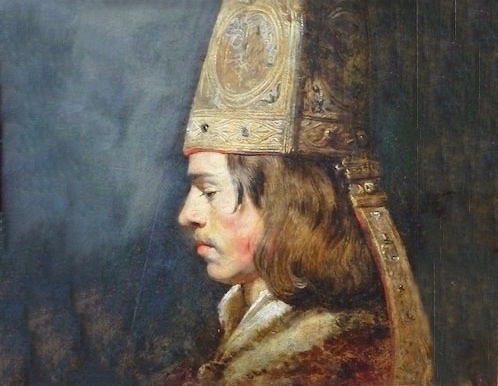
The painting above is titled “Young Man in a Mitre” (jeune homme a la mitre) by Pieter Van Mol, date unknown. I find this painting to be very beautiful and almost impressionistic. The face and hair are very finely executed while the details of the mitre and robe seem to have been intentionally blurred. The face seems bathed in light, and it is the face and hair that draw you in. The subject seems serious but perhaps because of the hair and age, I feel a tension between the responsibilities of the clergy and the natural exuberance of youth.

Pieter Van Mol (1599-1650) was a Flemish painter. His style was profoundly influenced by Rubens and Abraham Janssens. Once mistakenly considered a pupil of Rubens, he was actually an apprentice in 1611 with the little-known painter Siger van der Graeve and was received as master of the Antwerp Guild of St Luke in 1622. He set up a studio in Paris in 1631, where he received several commissions, such as one in 1635 for the frescoes in the chapelle du Sacré-Cœur in the église des Carmes, along with commissions from the queen. In 1640 he became the “ordinary painter” for Queen Anne of Austria. In 1648 he and other painters formed France’s Académie royale de peinture et de sculpture under the patronage of Cardinal Mazarin – this later became the Académie des beaux-arts. The painting above is “Jesus with a Cup”, date and location unknown to me. The model seems similar to Young Man in a Mitre.

The painting that he is best known for is the “Descent of Christ from the Cross” done in 1631, as seen above in the Louvre. This painting was probably done in Paris. The subject is treated as a lamentation for Christ. Mol shows clear influence from Rubens with a strong chiaroscuro (drama increased by shadows). This painting is supposed to have come from the church of the Petite Peres (closed in 1791 during the revolution) and transferred to the Louvre before the First Empire Department of Paintings. He did several other versions of this subject.
Notre-Dame-des-Victoires is one of ten minor basilicas located in the Île-de-France region of France. In 1619 the Discalced Augustinians (colloquially referred to as the “Petits Pères”) established their convent, Notre-Dame-des-Victoires, on three hectares of land they had purchased the Bourse (Market). It was closed during the revolution but reopened by Napoleon I (first empire). For much of the middle of the 19th century, Notre Dame des Victoires was the spiritual power-house of Paris. After the Blessed Virgin appeared to the pastor, Fr. Desgenettes in the early 1830s, he consecrated the parish to her, provoking a spontaneous revival of an almost dead parish. Notre-Dame-des-Victoires is famous for the ex voto offerings left there by the faithful. Over 10,000 devotional plaques, silver and gold hearts, as well as military decorations, have been left at the Basilica.

